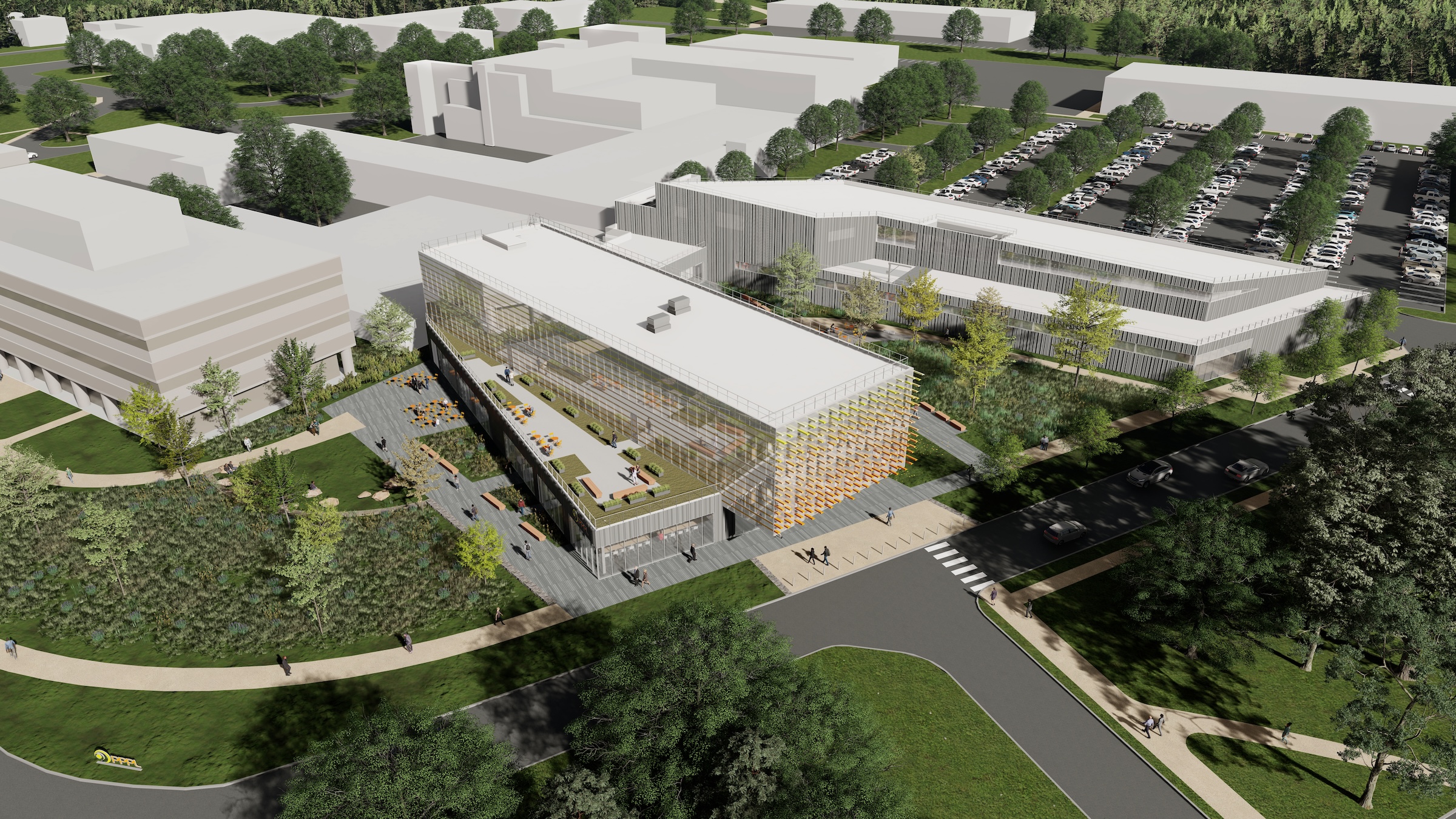In Princeton, N.J., the U.S. Department of Energy’s Princeton Plasma Physics Laboratory (PPPL) has broken ground on the Princeton Plasma Innovation Center (PPIC), a state-of-the-art office and laboratory building.
Designed and constructed by SmithGroup, the $109.7 million facility will provide space for research supporting PPPL’s expanded mission into microelectronics, quantum sensors and devices, and sustainability sciences. PPIC also will help the organization contribute research toward President Biden’s “Bold Decadal Vision for Commercial Fusion Energy.”
The first new building at PPPL in several decades, the 68,000-sf center will replace two buildings dating to the 1950s. The high-performance, sustainable building aims to be LEED Gold certified and a zero-carbon emissions building.
In addition to providing lab space, PPIC will have remote collaboration space and a virtual reality cube where PPPL scientists can communicate with research partners around the world. The building also will provide PPPL’s science education team a new lab for training the next generation of scientists.
In the U-shaped building, the north wing will feature a collaborative first floor where visitors enter, while the second and third floors will be dedicated mostly to office space for about 170 staff members. The laboratory wing to the south will have 10 medium-bay laboratories and 13 small-bay laboratories on the ground floor.
At the intersection of the north and south wings, the café will feature retractable walls on each side that open to the courtyard and the north garden, as will the science education lab and first-floor meeting rooms. A roof garden will sit north of the building entrance.
In line with the project’s focus on sustainability, glass will be used extensively to maximize daylight for the offices and reduce the use of electric lights. At the same time, colorful shades will reduce direct heat and glare from the sun by 88%, mitigating the need for air conditioning.
A geothermal exchange system, which will be dug 500 ft below ground between the north and south wings, will extract heat from the building in the summer and store it underground to heat the building in the winter. The system will provide about two-thirds of the building’s heating and cooling.
The project is primarily funded by the DOE’s Science Laboratories Infrastructure program, while Princeton University contributed $10 million for preconstruction work.
On the Building Team:
Owner: U.S. Department of Energy’s Princeton Plasma Physics Laboratory (PPPL)
Design architect, architect of record, and MEP and structural engineer: SmithGroup
Civil engineer: Van Note-Harvey Division of Pennoni
General contractor: INTECH Construction
Related Stories
BIM and Information Technology | May 8, 2023
3 ways computational tools empower better decision-making
NBBJ explores three opportunities for the use of computational tools in urban planning projects.
Mass Timber | May 1, 2023
SOM designs mass timber climate solutions center on Governors Island, anchored by Stony Brook University
Governors Island in New York Harbor will be home to a new climate-solutions center called The New York Climate Exchange. Designed by Skidmore, Owings & Merrill (SOM), The Exchange will develop and deploy solutions to the global climate crisis while also acting as a regional hub for the green economy. New York’s Stony Brook University will serve as the center’s anchor institution.
University Buildings | Apr 24, 2023
Solving complicated research questions in interdisciplinary facilities
University and life science project owners should consider the value of more collaborative building methods, close collaboration with end users, and the benefits of partners who can leverage sector-specific knowledge to their advantage.
Laboratories | Mar 9, 2023
5 laboratory design choices that accelerate scientific discovery
Stephen Blair, director of CannonDesign's Science & Technology Practice, identifies five important design strategies to make the most out of our research laboratories.
University Buildings | Feb 9, 2023
3 ways building design can elevate bold thinking and entrepreneurial cultures
Mehrdad Yazdani of CannonDesign shares how the visionary design of a University of Utah building can be applied to other building types.
Giants 400 | Feb 9, 2023
New Giants 400 download: Get the complete at-a-glance 2022 Giants 400 rankings in Excel
See how your architecture, engineering, or construction firm stacks up against the nation's AEC Giants. For more than 45 years, the editors of Building Design+Construction have surveyed the largest AEC firms in the U.S./Canada to create the annual Giants 400 report. This year, a record 519 firms participated in the Giants 400 report. The final report includes 137 rankings across 25 building sectors and specialty categories.
University Buildings | Feb 7, 2023
Kansas City University's Center for Medical Education Innovation can adapt to changes in medical curriculum
The Center for Medical Education Innovation (CMEI) at Kansas City University was designed to adapt to changes in medical curriculum and pedagogy. The project program supported the mission of training leaders in osteopathic medicine with a state-of-the-art facility that leverages active-learning and simulation-based training.
Mass Timber | Jan 30, 2023
Net-positive, mass timber building will promote research on planetary well-being in Barcelona
ZGF Architects, along with Barcelona-based firms MIRAG and Double Twist, have designed a net-positive, mass timber center for research on planetary well-being. Located in Barcelona, the Mercat del Peix Research Center will bring together global experts in the experimental sciences, social sciences, and humanities to address challenges related to the future of the planet.
Adaptive Reuse | Dec 21, 2022
University of Pittsburgh reinvents century-old Model-T building as a life sciences research facility
After opening earlier this year, The Assembly recently achieved LEED Gold certification, aligning with the school’s and community’s larger sustainability efforts.
Data Centers | Nov 28, 2022
Data centers are a hot market—don't waste the heat!
SmithGroup's Brian Rener shares a few ways to integrate data centers in mixed-use sites, utilizing waste heat to optimize the energy demands of the buildings.

















